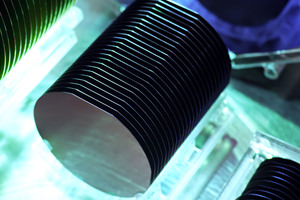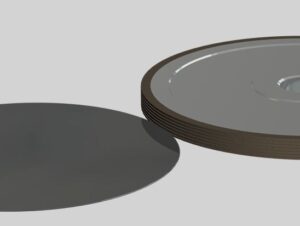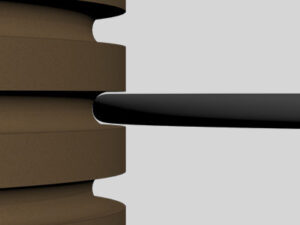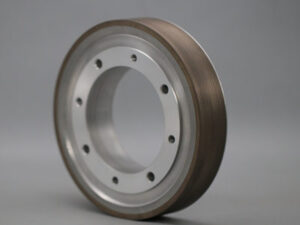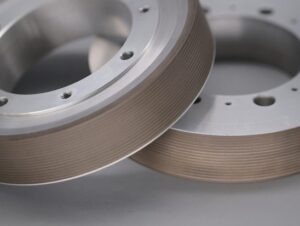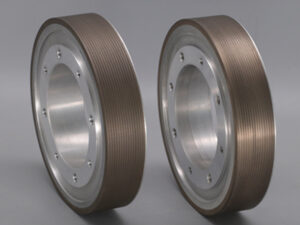How to choose edge grinding wheel for chamfering wafer
Why Chamfering is Important for Wafers
Wafers are thin silicon slices with a thickness of about 1 mm. Due to the very high process requirements of the manufacturing process, the surface of the wafer has a very high flatness. The specific application of the wafer determines what kind of crystal growth method needs to be adopted. Taking the Czochralski method as an example, after the polycrystalline silicon is melted, a pencil-sized seed crystal is immersed in the molten silicon, and then the seed crystal is slowly rotated and slowly pulled upward. So a very heavy single crystal silicon ingot is pulled out. In addition, the wafer can achieve targeted electrical properties by adding a trace amount of high-purity dopant to the molten silicon. The silicon ingot is doped according to the customer’s specifications, then sliced and polished.
In semiconductor production, wafer edge chamfering is a very important process. Since the wafer itself is a circle, the edge right-angle treatment will cause sharp edges and corners on the edge, which is easy to damage the wafer edge. It is also easy to have quality problems such as marks and scratches, which affect the subsequent production process and product quality. Therefore, in the semiconductor production process, wafer chamfering is an indispensable link. The chamfering process can not only make the wafer edge smooth, reduce damage and marks, but also improve product stability and reliability.
Single-crystal silicon is very fragile and has a high risk of breaking. Therefore, special care should be taken when chamfering to avoid mechanical damage to the edge of the wafer.
The unchamfered silicon wafer is placed on the grinding chuck, and the chamfering grinding wheel with a rounded groove grinds the edge of the wafer, so that the edge of the wafer engages the groove, and is chamfered multiple times by grinding wheels with different abrasives, so as to grind out the edge fillet that meets customer requirements. Chamfering is divided into T-type chamfering (large chamfer) and R-type chamfering (small chamfer).
1. The role of groove edge chamfering
Groove edge chamfering refers to chamfering the edge of the wafer during wafer processing. The main functions of this technology are as follows:
Improve the edge strength of the wafer: Chamfering can increase the thickness of the wafer edge and improve its mechanical properties such as bending resistance, torsion resistance, and compression resistance.
Reduce edge defects: Chamfering can effectively reduce the defect rate of the wafer edge and improve the product qualification rate.
Improve appearance quality: Chamfering can make the edge of the wafer smoother and more beautiful, and improve product quality.
2. The impact of groove edge chamfering on wafer edge protection
Force resistance: The force resistance of the chamfered wafer edge is significantly improved. According to experimental data, the force resistance of the chamfered wafer edge is more than 1.5 times that of the untreated wafer edge.
Wear resistance: The wear resistance of the chamfered wafer edge is improved. Under the same conditions, the wear amount of the chamfered wafer edge is only half of that of the untreated wafer edge.
Appearance quality: The chamfered wafer edge is smoother and more beautiful, which effectively improves the product appearance quality.
What is a Diamond Edge Grinding Wheel?
A diamond edge grinding wheel is a specialized tool designed for precision grinding of the edge or chamfer of hard, brittle materials such as silicon wafers, sapphire, and ceramics. The wheel consists of a metal or resin bond matrix embedded with synthetic diamond abrasives. These wheels are tailored for high-accuracy applications where both performance and material preservation are essential.
Edge grinding wheel, chamfering wheels for sapphire substrate, silicon carbide substrate and silicon wafer, liquid crystal panel, ITO glass, PDP glass, quartz glass, microcrystalline glass, photovoltaic glass, automotive glass. A small diamterer wheel for notch grinding.
How to Choose a Diamond Edging Wheel for Wafer Chamfering
Choosing the right diamond edge grinding wheel is key to achieving precise, clean chamfering with minimal surface damage. Here are critical factors to consider:
1. Bond Type
* Metal Bond: Offers excellent durability and form retention. Ideal for aggressive chamfering with long service life.
* Resin Bond: Provides superior surface finish but wears faster than metal bond. Suitable for applications requiring low material removal rates.
2. Grit Size
* Fine grit (e.g., 800# to 1200#) is recommended for fine chamfering and achieving high surface quality.
* Coarse grit (e.g., 200# to 400#) is used for fast material removal during rough chamfering.
3. Wheel Shape and Profile
The profile of the grinding wheel should match the desired chamfer geometry:
* V-shaped wheels: For angular chamfers
* R-shaped wheels: For rounded or radius edge chamfering*
* Custom shapes: Tailored to specific wafer edge profiles
4. Compatibility with Equipment
Ensure that the wheel dimensions (outer diameter, thickness, bore) are compatible with your grinding or chamfering equipment.
5. Wafer Material
Different wafers (e.g., silicon, sapphire, SiC) require different diamond concentrations and bond hardness. For example:
* Silicon wafers: Moderate bond hardness and diamond concentration
* Sapphire wafers: Harder bond and higher diamond concentration
Advantages of Metal Bond Diamond Edge Grinding Wheels
Among various types, metal bond diamond edge grinding wheels are widely preferred for wafer chamfering due to the following advantages:
1. Superior Durability
Metal bond wheels provide exceptional wear resistance, making them ideal for long production runs without frequent replacements.
2. Excellent Form Retention
These wheels maintain their shape over time, ensuring consistent chamfer profiles and reducing downtime for reshaping or dressing.
3. High Precision and Surface Quality
Metal bond wheels can achieve tight tolerances and excellent surface finishes, minimizing subsurface damage to wafers.
4. Cost-Effective Over Time
Though the initial cost may be higher, the extended lifespan and reduced downtime contribute to a lower total cost of ownership.
5. Compatibility with Automation
Metal bond wheels are compatible with high-speed, automated wafer chamfering systems, ensuring efficiency and repeatability.
Application Areas
Diamond edge grinding wheels are used extensively in the production and processing of:
* Silicon wafers
* Sapphire substrates
* SiC wafers
* Optical glass
* Photovoltaic cells
Moresuperhard: Your Partner in Wafer Processing Solutions
At Moresuperhard, we specialize in manufacturing customized metal bond diamond edge grinding wheels designed for wafer chamfering applications. Our wheels are engineered with premium diamond abrasives and advanced bond technology to ensure optimal grinding performance, durability, and wafer protection.
We offer:
* Customized wheel dimensions and profiles
* Bond optimization for various wafer materials
* Technical support for wheel selection and process improvement
—EDITOR: Doris Hu
—POST: Doris Hu

